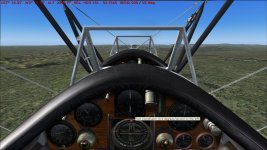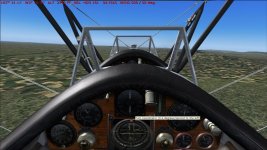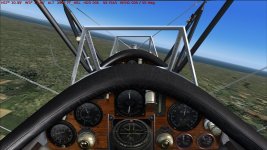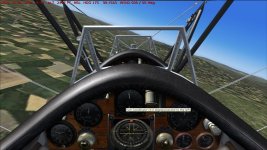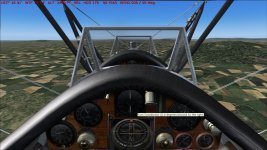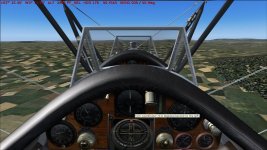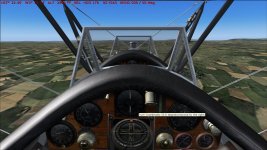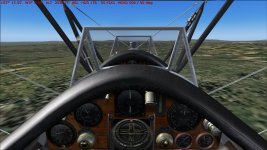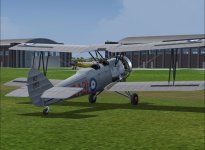-
There seems to be an uptick in Political comments in recent months. Those of us who are long time members of the site know that Political and Religious content has been banned for years. Nothing has changed. Please leave all political and religious comments out of the forums.
If you recently joined the forums you were not presented with this restriction in the terms of service. This was due to a conversion error when we went from vBulletin to Xenforo. We have updated our terms of service to reflect these corrections.
Please note any post refering to a politician will be considered political even if it is intended to be humor. Our experience is these topics have a way of dividing the forums and causing deep resentment among members. It is a poison to the community. We appreciate compliance with the rules.
The Staff of SOH
You should upgrade or use an alternative browser.
As the nature of things progress...
- Thread starter nigel richards
- Start date
Motormouse
SOH-CM-2025
My goodness, she's a sprightly thing for a fabric covered biplane, isn't she?!
Possibly a tad too sprightly, IMHO, Im going to have a play with the cfg...
Ttfn
Pete
Bushi
Charter Member
Possibly a tad too sprightly, IMHO, Im going to have a play with the cfg...
Ttfn
Pete
On my 'long' legs.. I'm finding her to be a bit of a pain! Yes.. the instability in the roll axis is most likely FAR more realistic.. but it's a pain trying to hold a course over....... oh lets say the featureless SAHARA... where you have no landmarks to aim at...and tough to read that old school compass!
My flight paths over a couple of hours of flying look like a drunken sailor!! LOL
I've actually gone back to the older flight model for the long distance jaunts as I continue my Sahara circumnavigation. but doing what she was designed to do... what a dream that 621 trainer is.. BRILLIANT!
Having ZERO clue on what to change so I can have two cfg.s to choose from while still enjoying the features of the new model, all of my 'attempts' to meld the old and new into a hybrid.. have met with abject failure!!
This is why I leave such 'magic' to the VERY talented wizards that know these things.. and stick to wielding a paint brush.....
Cheers
Dave
Bushi
Charter Member
Nice work Bushi -- I couldn't help but notice the last three letters of the registration on the tail... "BVR". "Beyond Visual Range"...The Yellow Paint version looks superb.


BB686
The yellow is just a rework of Nigels RCAF paint. I removed a whack of alpha, smoothed out the paint on the metal cowl, and for the floatplane version.. covered the landing gear holes, and played with the 'floatplane' specific bits..
Still working on paints by 'tinting' and edititng Nigels paints in photoshop as I do not have a paint kit.. so.. yeah.. the shadows under BVR's tailplane etc. are decidedly BLUE. Once the paint kit is available.. I can redo them properly...
Nigel KEEPS providing new, absolutely wonderful paints.. !!!! He's not leaving too many ACTUAL schemes for us 'creative types'!

oh, and the BVR.. TOTAL accident.. lol.. random letter pick.
Cheers
Dave
Motormouse
SOH-CM-2025
On my 'long' legs.. I'm finding her to be a bit of a pain! Yes.. the instability in the roll axis is most likely FAR more realistic.. but it's a pain trying to hold a course over....... oh lets say the featureless SAHARA... where you have no landmarks to aim at...and tough to read that old school compass!
My flight paths over a couple of hours of flying look like a drunken sailor!! LOL
I've actually gone back to the older flight model for the long distance jaunts as I continue my Sahara circumnavigation. but doing what she was designed to do... what a dream that 621 trainer is.. BRILLIANT!
Having ZERO clue on what to change so I can have two cfg.s to choose from while still enjoying the features of the new model, all of my 'attempts' to meld the old and new into a hybrid.. have met with abject failure!!
This is why I leave such 'magic' to the VERY talented wizards that know these things.. and stick to wielding a paint brush.....
Cheers
Dave
OK little experimentation, I think it needs a little more inertia in 'pitch' and 'yaw' ; those floats would be trying to act like a pendulum underneath and resisting sudden changes in direction ... more later
ttfn
Pete
Bushi
Charter Member
OK little experimentation, I think it needs a little more inertia in 'pitch' and 'yaw' ; those floats would be trying to act like a pendulum underneath and resisting sudden changes in direction ... more later
ttfn
Pete
I have not done any long distance flights in the floatplane yet.. My Sahara trip is in the 621 trainer with the 5 cyl mongoose, on those nice tall wheels. Wonderful little airplane for it, but now she is drifting.. developing a slight bank (left or right.. seems random) when flown hands off, and then a resulting turn.. which steepens over time. in calm air, the old flight model would be quite stable and rock solid on course and keeping the wings level.. (yes.. TOO stable, but suited my needs..
 )
)Dave
Apart from referring to the Tutor as a "gentlemanly little thing", he does comment about the difficulty in timely producing the instructor's patter for spin recovery.
Basically, it only needed the rudder to be centralised for the Tutor to start coming out of the spin, long before getting the rudder to the opposite side.
This meant that there was little time for the instructor to intone the standard patter, which was meant to be dinned into the skull of the student in the other cockpit as the manoeuvre progressed.
I hope you have included the Gosport tube for advanced communications! The trickiest part of the Instructor's course appears to have been getting the patter word perfect and timed to coincide exactly with the manouevres in each of the 28 prescribed sections of the training programme.
Looking forward to this splendid model and the quite amazing range of variances. Toodle pip old boy.
magoo
SOH-CM-2013
Just been reading Frank Tedrey's "Pilot's Summer", the tale of his experience at the Central Flying School in 1935.
Apart from referring to the Tutor as a "gentlemanly little thing", he does comment about the difficulty in timely producing the instructor's patter for spin recovery.
Basically, it only needed the rudder to be centralised for the Tutor to start coming out of the spin, long before getting the rudder to the opposite side.
LoL.....I guess we're not too far from the truth on this one. On the test table, I was able to (quite easily) adjust it to spin with the rudder held. The instant you centered the rudder, the model would straighten out and fly right.
In the absence of any information, there I was looking for a spin somewhat like a Stearman, with a little Tiger Moth mixed in, the normal sort that required corrective input. Sounds like the Tutor was far more gentlemanly than I suspected!!

Poor Keith is hammering away on a solution as well.
Okay....now I understand why the Tutor was resisting us so much. We've hardly gotten to know ya, Sweetie!!
Regarding long distance flights.....what's the plane doing.....hunting about on a particular axis...? Perhaps weather-van(ing) a bit much as it rolls? Was the flight happening with wind(s) or turbulence being generated?
Let me know, there's going to be at least another sorting through the whole range of flight models, a small list of items that'll be fine tuned. The beta flight tests are the time to deal with this stuff easily, before it's all issued to the unsuspecting flightsim public.
Comments please, they will be noted.

Arl, thanks for posting, that bit of info has saved us a growing sense of futility and the accompanying headache, trying to solve that which needed no solution, only a tiny tweak.
I'll look into getting the book!!
Bushi
Charter Member
LoL.....I guess we're not too far from the truth on this one. On the test table, I was able to (quite easily) adjust it to spin with the rudder held. The instant you centered the rudder, the model would straighten out and fly right.
In the absence of any information, there I was looking for a spin somewhat like a Stearman, with a little Tiger Moth mixed in, the normal sort that required corrective input. Sounds like the Tutor was for more gentlemanly than I suspected!!
Poor Keith is hammering away on a solution as well.
Okay....now I understand why the Tutor was resisting us so much. We've hardly gotten to know ya, Sweetie!!
Regarding long distance flights.....what's the plane doing.....hunting about on a particular axis...? Was the flight happening with wind(s) or turbulence being generated?
Let me know, there's going to be at least another sorting through the whole range of flight models, a small list of items that'll be fine tuned. The beta flight tests are the time to deal with this stuff easily, before it's all issued to the unsuspecting flightsim public.
Comments please, they will be noted.
Arl, thanks for posting, that bit of info has save some futile headaches for those of us who try and fight the laws of physics......even in the abstraction of a desk top flight simulator.
I'll look into getting the book!!
LOL.. a Stearman ..SHE IS NOT!!! yes.. more like the Moth..
Okay.. so.. dead calm air, about 2500 feet, cruising along at 97 or so mph. The old flight model was extremely stable.. once you had her wings level, no yaw, and trimmed wirh elevator and power to maintain altitude more or less, she would cruise along happily at a given heading with no wavering. no bank, no yaw.. just fly straight as an arrow.
The new one, feels like it's balancing on a beachball in trimmed level flight. It's a bit difficult to get it to stay on a heading to begin with, and then, once hands off the joystick, the deviation begins, and continues to get worse until you are in a descending tightening turn.
I just flew the old and new model back to back and took screenshots of each, while I timed the flight.
First up is the NEW flight model.. from left to right.. BASE (when I let go of the stick once trimmed and level.... second, at TWO minutes hands off, then FOUR, and finally FIVE. I left the flight info visible across the top of the screen.
I'll post the screenshots of the old flight model in a post below...
Attachments
Bushi
Charter Member
And here is the old flight model...
Same thing . first screenshot was after establishing level trimmed wings level flight... SECOND at two minutes, THIRD at four minutes, and the FINAL one at TEN minutes..
ZERO deviation from the original heading...wings still level... About as stable as an airplane can get!!! LOL
I occasionally step away from the stick when flying.. especially long distances.. (I know I know..
Anyway, there you have it.. my 'two cents' . Yes.. the older flight model was probably TOO stable.
Oh, I'm also doing all of this flying in the 621 TRAINER with the five cyl mongoose engine. I have NO idea if the later Tutor model does this.
Cheers
Dave
Attachments
magoo
SOH-CM-2013
Thanks for the deluxe reply, "plus-rapido!!"
There's a couple of things going on there, but now I know what to do.
Regarding stalls and Stearmans & Moths....
>...I agree.....the Tutor is NO Stearman......nor does it live in the same universe as the Tiger Moth. One could, perhaps draw a comparison to post-war Stearman as flyers began to mod them out for airshows.....doubling up the ailerons.....you know....
......A 621 with an R-985....that'd be a toy!!
There's not a lot of info out there about what the Tudor series was like to fly. The accounts of the Shuttleworth plane are not so usable as it is the only flyable one, with the only operating Lynx radial. It's so heavily babied, I'm surprised it actually gets airborne.
I've ended up going through old British aviation magazines from the early thirties, gleaning anything that can be found about this line of aircraft and engines....often without deference to specs you'll find on today's internet.
Stalls are refered to in the most vague, as in describing the Tutor's range of duties, "takeoff, landing, turns, stalls, spins, formation flying, etc......."
Doesn't tell you much.
What next.....?
Comparable aircraft that do have a lot of data, and then factor in the obvious differences. Not optimum....but certainly something to sink one's teeth into.
The Tiger Moth is only notable because it came next in line, and there's a lot of them still around, so a lot of data. It's spin is extreme enough for the time that the RAF felt compelled to have De Havilland install strakes as a way of making the manouvre more manageable.
Okay...that's one extreme end.
Back the other way, I look around and see a lot of PT-17 Stearman still around. Lot (LOTS) of data there.
Similar, but very different.
The 621 came along just at 1929, and was designed with a lot of advanced technology for the time. Steel tube construction, including wings and tail. Leading edge slats, two sets of aileron (4), fuselage paneling that could be removed easily, exposing the fuselage interior from behind the engine all the way back to the aft cockpit.
In comparison, the Stearman's empty weight was roughly one hundred lbs higher. The Avro's wingspan was about two feet wider. The Lynx radial generated about 20 HP more than the Continental, and while the Stearman's fuselage was a chromoly steel cage, wings (& tail?) all wood.
Avro 621 built in peace time, almost a decade earlier, fewer planes each with a higher price tag, with a maximum possible service life envisioned.
Boeing PT-17 created during the obvious build-up to war, using fewer strategic materials, with a lower price tag, and arguably with the intent of filling a rapid demand roll where the aircraft could be considered easily expendable. I can't say it featured any new technology, simply tried'n'true stuff, a good bang for the buck. (experts?)
Both planes could be seen to have a similar envelope in regular flight , the same mushy straight ahead stall, the Avro could certainly be seen as more capable in full-out aerobatics. ( But still a big plane compared to something like a Jungmann, let's not even mention the Jungmeister....)
Now we've received a glimmer of info stating that the 621 would hold a spin as long as the pilot held the rudder out, and then would correct itself.
Muy Claro!!
I'm aware that the PT-17 will hold the most lovely, slow motion spin.......but I've only seen it from the ground. Does the pilot have to maintain rudder input to maintain the spin, or will the plane continue chasing it's tail with controls released, requiring the pilot to correct to resume normal flight? (This one's for my curiosity only...)
Bushi
Charter Member
Okay, So... early this morning.. decided to actually SEE and FEEL what the LATE floatplane actually felt like on a cross country..
WELL... surprise !!! Once trimmed out and flying along the amazon at a little under 1000 feet, she was FAR more stable than the wheeled mongoose powered 621 trainer in level flight, with deviation from heading and a wings level attitude negligible... A pure JOY to relax and fly along in.. this is the close cowled Lynx 7 cyl airplane on floats were talking about here..
So.. pull up BOTH cfg.s.. side by side.. have a look.. compare..
Some minor differences in the [airplane geometry]... so.. copy and paste entire section over into the wheeled 621.. (leaving all weights.. EVERYTHING else the same. )....MARKED improvement!!
The twitchiness I was experienced just by clicking the trim button on the joystick was gone.. and she was far more fluid and predictable with tiny movements of the stick in all axis to correct small course deviations (I use a twist grip for rudder)
The BIGGEST difference in the two cfg.s as far as airplane geometry is concerned was the aileron area. The 621 trainer was 25.. while the floatplane was 35 (quite possibly a typo in the file causing some issues here!! )

Other than that, it's a few little differences in rudder, as each has a different shape.. but .. hey.. this was a marked improvent ..
After FIVE minutes of hands off flight... She STILL wanders off on her own (I'm thinking of naming her Dory) but quite a difference from the previous "wanderings" and twitchiness!..
Anyway.. a bit more info on the matter.. and to add.. what a wonderful airplane set this is.. Kudo's on the whole FDE issue!! We will get a perfect airplane out of this!!
Cheers
Dave

Hopefully between us (Magoo & I) we can come up with an acceptable solution, which might read through to the other models.....? So far I'm having difficulty in getting it to do a medium to flattish spin - it seems way too steep at the moment, but it does recover easily by setting rudder to neutral. Jerry Beckwiths FDWB has not helped so far either.
I do have RW experience of a spin or two in a Tiger, but way, way back in 1957, (thats 60+ years ago!) so memory fade can come into play there & it doesn't help the FDE figures either!
Nil desperandum
Keith
Motormouse
SOH-CM-2025
How does the stall AOA marry up; to me seems a little too high IIRC slats add about 3 degrees to stall AOA (been a long time since I have read Kermode's book)
I've been looking at the MOI figures in the Sea Tutor .cfg file; really need an accurate overall length to play with
I've estimated at 32ft (@ 5 ft extra for floats from 26ft standard) ... magoo ignore those I sent via PM ... I made an oops there.
ttfn
Pete
621 pitch = 1442, roll = 1015, yaw = 1963
646 pitch = 2423, roll = 1365, yaw = 2920.
now for comparison I have been using the Discrete values coughed up in FDWB for the 621;
pitch= 2150, roll = 1257, yaw = 2878.
FDWB also shows the FS SDK values for the 621 as
pitch = 1610, roll = 1155, yaw = 2215
So you could factor the ACM values of the Sea tutor by the percentage differences etc of your choice!
Having written that, it now gives me another alley to get lost up - hoping its not a dead end!
Happy landings - they are all good if you can walk away from them - drones/ UAV's ( Jindivik) especially
Keith
Slats - not sure how or if FS FDE's apply extra AoA for them - maybe AFSD might tell me. 3° might be what you would get if the whole span of a wing were equipped - Zoenkonig ? dont know if spelt correctly.
K
nigel richards
Charter Member
Glad you know how to make sense of it all Keith, D***ned if I do with table this and table that, and I fix real planes!
How does the stall AOA marry up; to me seems a little too high IIRC slats add about 3 degrees to stall AOA (been a long time since I have read Kermode's book)
I've been looking at the MOI figures in the Sea Tutor .cfg file; really need an accurate overall length to play with
I've estimated at 32ft (@ 5 ft extra for floats from 26ft standard) ... magoo ignore those I sent via PM ... I made an oops there.
ttfn
Pete
Not far off the mark, Pete - 29'8" from here (float tip to tail light bulb).
nigel richards
Charter Member
Yaw in S+L flight is there because of p factor on yaw - it gives about 1° right wing down, if you switch it out in the aircraft.cfg she will stay wings level with no drift.
Pete, all variations in MoI in 621 aircraft work OK, although the smaller values make recovery quicker.
According to AFSD Slats do show an increase in AoA at the stall, difficult to define actual value but seems to be about 5 to 10°, no appreciable speed difference though with my Cl vs AoA graph as dont know how FS works it out.
Getting closer to an acceptable spin, but more fine tuning, turns better RH rather than LH - ? p factor on yaw? Greasy pole syndrome possible though!
Yard arm time here....

Keith


